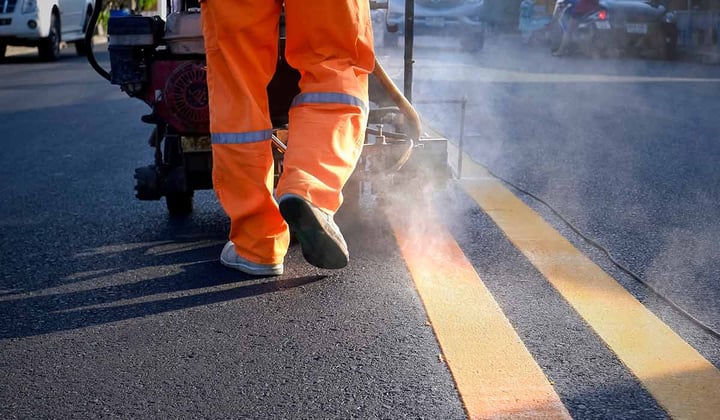Painting roads involves applying markings to create lanes, signals, and directions. This practice enhances traffic flow and road safety.
Road painting is crucial for maintaining orderly traffic movement and ensuring the safety of both drivers and pedestrians. Specialized road marking paint, which is durable and reflective, is used to create various signs on the pavement such as lines, arrows, and pedestrian crosswalks.
These markings provide guidance and information to road users, contributing to a reduction in accidents and traffic congestion. The process typically requires precise machinery and skilled workers who follow strict transportation regulations. As driving conditions evolve and cities grow, road painting remains an essential service for urban planning and infrastructure maintenance, keeping the roads clear and navigable for all vehicles.
Introduction To Road Markings: The Synergy Of Aesthetics And Function
Road markings blend beauty and safety on our streets. They guide drivers and walkers. Painted lines, symbols, and designs make roads safe and attractive. This post explores road markings from their history to dual roles in art and safety.
The Evolution of Street Marking: A Historical Perspective
The Evolution Of Street Marking: A Historical Perspective
Long ago, stones and carvings showed the way. Modern road markings began in the early 1900s. First lines were white, then came yellow. Today’s materials last longer and are seen at night.
Understanding the Dual Role of Road Paintings: Artistry Meets Safety
Understanding The Dual Role Of Road Paintings: Artistry Meets Safety
Road paintings do two things. They make travel safe and streets look good. Bright colors and clear lines prevent accidents. Creative designs and patterns enhance town looks. Safety and beauty work together.
The Science Behind The Paint: Composition And Durability
Road painting may seem simple, but it’s a blend of science and engineering. Durable road paint withstands extreme weather, heavy traffic, and time itself. Let’s dive into the materials and technologies that make road paint last and how it helps keep drivers safe at all hours and conditions.
Materials And Technologies: What Makes Road Paint Last?
Road paint needs to stick around. It’s made from different materials including:
- Acrylics: For flexibility and durability.
- Alkyds: An older type, now less common due to environmental concerns.
- Epoxy: Known for strength and longevity.
- Polyurethane: Hits the mark for toughness and resilience.
- Thermoplastic: Offers high visibility and skid resistance.
Technology keeps paving the way for paints that last longer. Beads mixed in the paint reflect light, helping the lines stay visible.
Innovations In Reflectivity: Ensuring Visibility In Diverse Conditions
Night or rain, road lines must shine. Innovations in reflectivity include:
| Component | Function |
|---|---|
| Glass Beads | Bounce back headlights for night visibility. |
| Microcrystalline Ceramic Beads | Extra reflectivity under rain or fog. |
| Retroreflective Elements | Enhance line visibility in all weather. |
Environmental Considerations And Sustainability In Road Paints
Today’s road paint is greener. Major changes include:
- Ditching harmful solvents for waterborne paints.
- Using recycled glass beads for reflectivity.
- Exploring bio-based materials to replace traditional plastics.
Manufacturers aim for paints that last longer and are harmless to our planet. These steps not only reduce pollution but also cut down on the need for frequent repainting.
Design And Application Techniques: From Concept To Concrete
Imagine a world where roads tell us stories, guide our paths, and ensure our safety. The painting of roads is both an art and a science. It starts with a creative concept and ends with precise execution. Designing and applying road paint involves planning, regulations, and a splash of creativity. This segment delves deep into the world of street markings, from strict guidelines to unique artistic expressions on concrete.
Standardizing Street Markings: Regulations And Guidelines
Uniform street markings maintain order and ensure safety on roads. Globally, governments set stringent regulations. Road designers must follow these to create consistent and recognizable patterns for drivers and pedestrians alike.
- Mandatory color schemes
- Specific dimensions for lines and symbols
- Reflectivity standards for visibility
These rules make sure all road markings meet clear visibility and durability standards.
The Process Of Painting Roads: Steps And Strategies For Effective Application
Selecting the right paint for a road is crucial. The process involves meticulous steps to ensure lasting results:
- Surface cleaning and priming
- Choosing the correct paint type
- Applying paint in optimal weather conditions
- Ensuring proper drying time
Techniques such as thermoplastic application are popular for high durability.
Creative Markings: Exploring Unique And Artistic Street Designs Globally
Streets can be canvases for spectacular art. Across the world, vibrant designs transform ordinary roads into landmarks:
| Country | Featured Design |
|---|---|
| Spain | Colorful, geometric patterns |
| USA | Crosswalks with community themes |
| Iceland | 3D zebra crossings for enhanced safety |
Innovative paints and techniques bring these designs to life, creating engaging and interactive street landscapes.

Credit: www.nytimes.com
Safety And Societal Impacts: How Road Markings Shape Behavior
Road markings play a crucial role in guiding and protecting road users. They shape behavior in subtle but significant ways. Clear, visible lines help drivers navigate roads safely. They also provide vital information to pedestrians. These painted guides are more than traffic directives; they influence society as a whole.
The Psychology Of Road Markings: Influences On Driver And Pedestrian Behavior
Road markings send important signals to those who share the streets. A solid line suggests no passing, whereas dashed lines invite drivers to make a decision. This level of communication is psychological. It encourages compliance and instills a sense of order. For pedestrians, crosswalks denote safety and the right of way. Without words, these lines impact thoughts and actions.
Case Studies: The Effectiveness Of Road Markings In Accident Prevention
Various case studies highlight the impact of road markings on accident rates. One study found that enhanced road striping reduced accidents by up to 30%. Another research indicated that areas with well-maintained lines saw a lower incidence of pedestrian accidents. These numbers stress the role that clear markings have in keeping roads safe.
Beyond The Lanes: How Street Art And Markings Affect Community And Culture
Road markings extend beyond functionality. In many places, street art is woven into the roads, creating vibrant venues for culture. These installations spark dialogue, promote local identity, and can even slow down traffic, making streets safer. Communities bond over these colorful displays, highlighting the cultural importance of what we paint on our roads.
Challenges And The Future Of Street Markings
Roads tell a story. They guide, warn, and regulate. Yet, they face a silent struggle. As we brace for future advancements, let’s explore the hurdles and opportunities that lie ahead for street markings.
Maintaining Quality And Compliance Over Time: The Ongoing Battle
Maintaining road markings is crucial for safety. Factors like weather, traffic, and time cause wear and tear. To fight deterioration, road authorities set compliance standards.
- Regular inspections ensure markings stay bright.
- Frequent retouching combats fading and damage.
- High-quality materials extend lifespan.
With tight budgets, maintaining this balance remains a constant battle.
Smart Roads And Interactive Paints: The Next Frontier In Road Markings
Innovation leads to smart road technology. Interactive paints that charge during the day and glow at night enhance visibility.
Imagine a road that communicates with drivers. It warns of hazards with changing colors. It’s not just a vision; it’s the near future.
Integrating Autonomous Vehicles With Road Marking Technologies
Self-driving cars need clear markings. The fusion of autonomous tech with road surfaces is vital.
New paints and sensors work together. They guide these vehicles safely. This integration is key for a harmonious transition to autonomy on the roads.

Credit: blog.asphaltkingdom.com
Frequently Asked Questions On Painting Roads
Does Painting Roads White Work?
Yes, painting roads white reflects sunlight, reduces urban temperatures, and can combat heat islands. This practice is environmentally beneficial but comes with durability concerns.
Why Is California Painting The Roads White?
California is painting roads white to reflect sunlight and reduce urban temperatures. This process, known as cool pavement treatment, aims to combat heat islands and improve comfort in city environments.
What Cities Are Painting Roads White?
Several cities, including Los Angeles, Athens, and Tokyo, have experimented with painting roads white to reduce heat absorption and combat urban heat islands. This initiative reflects ongoing efforts to address climate change impacts.
How Do People Paint Roads?
Road painting involves cleaning the surface, marking guidelines, and applying thermoplastic or paint using a road marking machine. Operators accurately apply reflective beads for visibility. Regular maintenance ensures clear road markings.
Conclusion
Embracing innovative road painting techniques can revolutionize safety and aesthetics on our streets. By incorporating reflective paints and creative designs, we enhance visibility for drivers and pedestrians alike. Let’s strive to make our roads not just thoroughfares, but works of art that protect and inspire.
Choose vibrant colors, and let’s paint the path to a brighter, safer future.

Steven is a professional cyclist and his passion is cycling. He has been cycling for the last 6 years and he loves using bikes while outing as well. Based on his experiences with the different types of bikes; he is sharing his opinions about various bikes so that a beginner can start right away. Find him on Twitter @thecyclistguy Happy Biking.


Leave a Reply